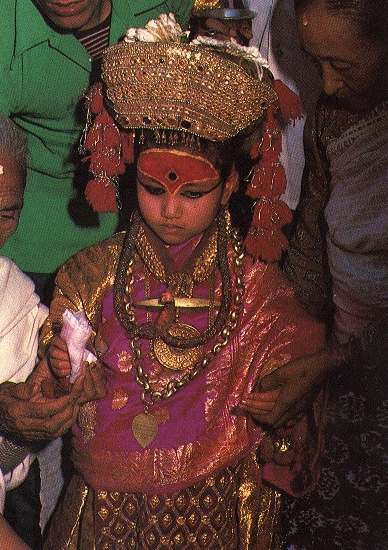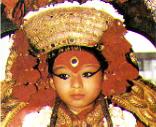During my visit to Nepal, my group was taken to see many sights. On one afternoon, we were taking a tour of Kathmandu's Durbar Square. I had grown quite accustomed to being an outsider in this country. The hawkers swarm around you as they try to sell you their wares. They shove interesting items into your face while they are pushing past each other to gain your attention. These were the circumstances as we were trying to make our way down a street. The sellers were swarming around us while the traffic was erratic as usual with no plan of movement. The travelers tried to swerve all around us, the hawkers, and the random animals that were loose in the streets. Between the chaos of the honking of cars and the chatter of the hawkers, I almost missed our guide motioning for us to move through a doorway. When I finally got to where I could hear him, he was saying in his accented English, "Hurry! Hurry! You'll be able to see her."
"What's going on?", I asked.
He gently pushed me on into the doorway saying, "You're going to miss her! Go! Go!"
I went on through the small doorway, and walked to the edge of a covered porch-like structure. Steps were set into the edge and they led down into a courtyard. I chose not to go on down

What is the Kumari?
Nepal has many different gods and goddesses. Many are Hindu and others are Buddhist. The Nepalese have many facets to their religious pantheon; and many are incarnations, manifestations, and aspects of the different major gods and goddesses. However, they have one unique aspect of their Hindu religion, the Kumari Devi. She is an actual living goddess in the flesh. Her titles are the Kumari Devi, the Royal Kumari, or the Virgin Goddess. She is worshiped as the incarnation of the Goddess Teleju Bhawani or the young incarnation of the Goddess Durga. Her worshipers consists of Hindu devotees and the Nepalese Royal Family. The high priest of the Taleju temple, worships her daily. There are other Kumari's besides the royal one. There is a Kumari in every town and village in the Kathmandu Valley. However, the Royal Kumari is the most important one. If the rural people can not make it to worship her at one of her festivals then they worship their youngest daughters as the Kumari.
Worship of the Virgin Goddess was established in the 16th century. There are three legends alluding to the beginning of Kumari worship. The first tells of a Malla king having sex with a pre-pubescent girl. She dies from the encounter, and he begins the practice of installing a young girl as a living goddess to redeem himself. The next is about a Malla king who plays dice with the patron protective goddess of Kathmandu Valley, Taleju Bhawani. It appears that the king makes an unwarranted pass at the Goddess and she takes away her protection of the Valley. After a time, she relents and promises to return in the form of a young girl. The third tale is about a young girl being banished from the kingdom, because she is possessed by the Goddess Durga. The queen is angered by the banishment. She orders her husband to return the girl and establish her as an incarnation of Durga.
Once the Kumari is selected she moves to Kathmandu with her family. They live in a temple/house called the Kumari Chhen on the southern end of Durbar Square. Her normal life consists of playing with the children of her attendants and having a private tutor. Every day attendants adhere to her every need. They bathe her and adorn her in sparkling red robes and glittering jewelry. They paint black lines around her eyes and draw a third eye on her forehead. Her public duties consist of making occasional appearances at a carved window at Kumari Chhen; and engaging in about six ceremonial festivals a year. The largest is the August-September festival of Indra Jatra. During this festival the Kumari is taken through the city on a temple chariot for three days and she blesses the King of Nepal.
The young girl stays the Kumari until she has her first menstrual cycle or suffers a serious loss of blood. At this point she is thought to have lost her divinity, and the search for a new Kumari must begin. While being a Kumari, she is supported by temple income. When she retires from being the Kumari, she is paid a grand dowry. The bad part is that it is considered unlucky to marry an ex-Kumari.
- Five senior priests choose girls from the Newar Shakya caste of silver and goldsmiths.
- The girls must meet 32 strict physical requirements. These requirements range from eye color and shape of teeth to the sound of their voices. They have to be between the age of four and puberty. Horoscopes must match that of the King's to ensure compatibility, because the Kumari has the power to confirm the King's rule.
- The girls who meet the physical requirements are subjected to many rigorous tests. The most intense test is when the girls are surrounded by terrifying noises in a dark room. Men dance around them in horrific masks and they are subjected to bloody buffalo heads that are remains of sacrifices to Kali during the Dasain festival. The frightening occurrences in the dark should not scare or upset a real goddess, much less one that is an incarnation of Durga. The young girl who remains calm during this last test is obviously the Kumari.
- As the final confirmation, the girl has to choose the items of clothing and decoration worn by her predecessor.

Like my page?
Email me! [[email protected]]